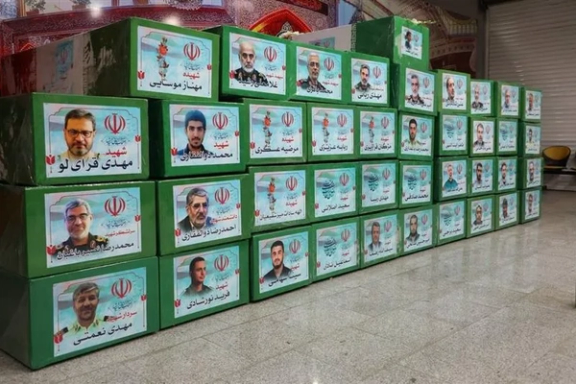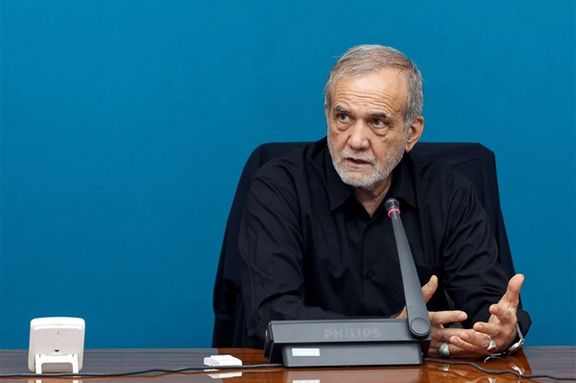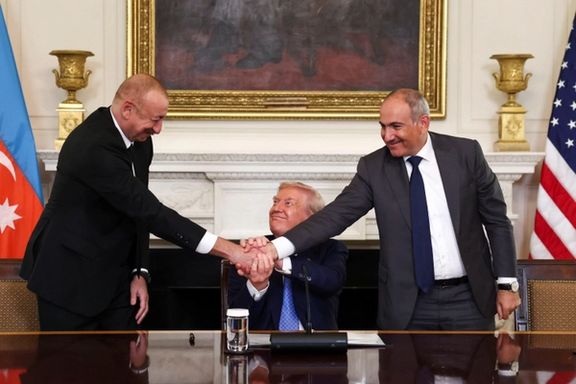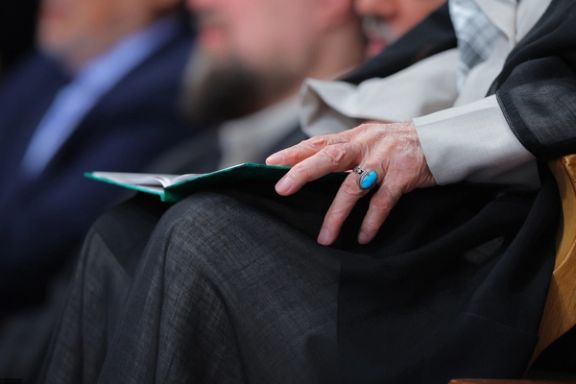450,000 Afghans sent back from Tehran, governor says

More than one million migrants were returned from Iran to Afghanistan over the past 100 days, including 450,000 from Tehran province, Tehran’s governor said on Saturday.

More than one million migrants were returned from Iran to Afghanistan over the past 100 days, including 450,000 from Tehran province, Tehran’s governor said on Saturday.
“Those without legal documents were identified and transferred to border crossings shared with Afghanistan and returned to their own country,” Mohammad Sadegh Motamedian told reporters on Saturday.
“Managing foreign nationals was one of the priorities of the government,” he said, adding that half of all foreign nationals in the country reside in Tehran province, prompting a province-wide identification effort.
Last year, more than 6,000 classrooms in the province were used by over 220,000 foreign national students, according to the governor.
“This year, families can register their children in those schools, which means existing educational capacity without building new schools will be available to our own students.”
In late July, Amnesty International called on Iran’s interior minister to take urgent action to halt the expulsions of Afghans.
The group said more than one million Afghans, including Iran-born individuals and long-term residents, had been forcibly returned to Afghanistan in recent months. Amnesty linked the mass returns to the escalation of hostilities between Israel and Iran, saying over half a million Afghans had been expelled since June 1, including thousands of unaccompanied children.
The organization said millions more remain at risk, particularly women and girls, who “must be treated as prima facie refugees and not returned to Afghanistan, where the Taliban are committing the crime against humanity of gender persecution against them.”
In previous remarks, Iranian officials have framed deportations as part of efforts to regulate residency and ease pressure on public services in areas with high concentrations of foreign nationals.

Over 40 days after a 12-day war with Israel left dozens of senior Revolutionary Guards dead, key command posts in Iran’s military remain unfilled, raising questions over the Islamic Republic’s operational cohesion.
The aftermath of Israel’s strikes, which dismantled parts of Iran’s military command structure in hours, continues to reverberate through the Revolutionary Guards.
The targeted attacks killed over 20 senior commanders, including Mohammad Bagheri, Chief of Staff of Iran's Armed Forces; Hossein Salami, IRGC Commander-in-chief; and Gholamali Rashid, Head of Khatam al-Anbiya Central Headquarters.
Some commanders died in their homes, others in a secure bunker during an urgent meeting said to be convened after a cyber-generated fake message.
In the immediate response, the system moved quickly to announce replacements — Abdolrahim Mousavi as new Chief of Staff of Iran's Armed Forces, Mohammad Pakpour as IRGC Commander-in-chief, and Ali Shadmani at Khatam al-Anbia.
Within five days, Shadmani was killed in what his daughter described as a car chase by an Israeli hit team.
The daily Kayhan wrote another commander had been appointed but withheld the name for security reasons, a report officials have neither confirmed nor denied.
Iran International’s review shows that other key posts remain vacant: the Armed Forces’ Deputy for Operations, previously held by Mehdi Rabbani; the Deputy for Intelligence, formerly Gholamreza Mehrabi; the IRGC Aerospace Force Intelligence post left by Khosro Hassani; and several regional intelligence commands.
Many of the 30 senior officers killed have yet to be replaced.
The attacks on June 21 also struck the IRGC’s external arm, killing Mohammad Saeed Izadi, who oversaw Palestinian operations, and Mohammadreza Nasirbaghban, the Quds Force’s deputy for intelligence. No successors have been named, even as Tehran seeks to rebuild its regional alliances after the conflict.
Silence surrounds IRGC navy chief’s absence
IRGC Navy chief Alireza Tangsiri has been absent from public view for nearly two months.
Tangsiri, who between late-March and early June appeared in over 20 official interviews and speeches in nearly 75 days and repeatedly issued harsh warnings to the US and Israel, has had no public or media presence for almost two months, since just before the war began.
On August 8, state media published a written message under his name for National Journalists’ Day, but it remains unclear if he authored it.
A source familiar with the matter, speaking anonymously, said Tangsiri has cancer and that his deteriorating health has kept him out of public events.
His absence, coupled with the unfilled naval command posts, is costly for the armed forces’ structure.
Attempted fixes and lingering risks
In an effort to restore coordination, the Islamic Republic has formed a Defense Council comprising representatives from the army, IRGC, intelligence ministry, and general staff. Chaired by the president, with Supreme Leader envoys Ali Shamkhani and Ali Akbar Ahmadian as members, the council is intended to bridge operational gaps.
Still, without permanent appointments to critical posts — especially in operations, intelligence, the Quds Force, and the navy — Iran’s military command remains in flux.
The continuing vacancies, layered over the unprecedented loss of top brass, point to more than a temporary disruption. They suggest a deeper challenge to the Revolutionary Guards’ ability to maintain both strategic direction and battlefield command.

Iran’s president said on Saturday that Israel’s attack on the country during the June 12-day war was carried out under US direction and in pursuit of Washington’s objectives.
“The Zionist regime, with the guidance and support of America, attacked Iran, and this attack was in line with America’s objectives,” President Masoud Pezeshkian said in remarks broadcast on state TV. He said the aim was to create chaos through “blind strikes” and the assassination of military commanders, scientists and civilians.
Twelve-day war
Iran and Israel fought a 12-day conflict in June that included US strikes on Iranian nuclear facilities at Isfahan, Natanz and Fordow, and Israeli strikes that destroyed critical infrastructure, killing several senior military and scientific figures as well as hundreds of civilians. Iran responded with missile strikes that killed at least 27 Israeli civilians.
Pezeshkian said the attackers aimed to spread unrest but failed. “The people, with their presence on the scene and their resistance, were victorious,” he said, adding that even prisoners and political opponents joined in defending the country. “When it comes to the security and independence of the country, all differences fade and the principle is Iran.”
Trump’s comments on Iran
President Donald Trump on Wednesday described Iran as “a very evil place” and credited US action with preventing wars across the Middle East by crippling Tehran’s nuclear program. “We have stopped wars in the Middle East by stopping Iran from having a nuclear weapon,” he said. “They can say they’re going to start all over again. But that’s a very dangerous thing for them to do, because we’ll be back as soon as they start.”

Iran cautioned on Saturday that any foreign interference near its borders could undermine security in the South Caucasus after Armenia and Azerbaijan signed a US-brokered peace agreement.
“We express our concern about the negative consequences of any foreign intervention, especially in the vicinity of our shared borders, that could harm the region’s lasting security and stability,” the foreign ministry said in a statement.
It said Iran “welcomes the finalization of the peace text by the two countries” as “an important step in achieving lasting peace in the region,” but added that projects near its borders should be developed “within the framework of mutual interests, with respect for national sovereignty and territorial integrity, and without foreign interference.”
Agreement signed in Washington
The announcement came a day after Armenian Prime Minister Nikol Pashinyan and Azerbaijani President Ilham Aliyev signed the agreement at the White House with US President Donald Trump. The agreement includes exclusive US development rights to a strategic transit corridor through the South Caucasus that the White House said would facilitate greater exports of energy and other resources.
That route will connect Azerbaijan and its autonomous Nakhchivan exclave, which are separated by a 32-kilometer-wide (20-mile-wide) patch of Armenian territory. The deal includes an agreement that will create a major transit corridor to be named the Trump Route for International Peace and Prosperity, the White House said.
Armenia and Azerbaijan have long been in conflict over territory and fought several wars. Russia acted as the main mediator for years, but its influence has declined since its 2022 invasion of Ukraine.
Tehran calls for regional framework
The ministry said Iran is ready to continue “constructive cooperation” with Armenia and Azerbaijan through bilateral and regional channels, including the 3+3 mechanism, which brings together Armenia, Azerbaijan and Georgia with Iran, Russia and Turkey to address regional issues without outside powers.

The Oct. 7 Hamas attack on Israel was the result of years of planning by Iran, Mohsen Mahdian, managing editor of the state-run Hamshahri daily, said on Friday in remarks published on Supreme Leader Ali Khamenei’s official website.
Mahdian tied the June 12-day war between Iran and Israel to what he called the same long-term strategy that led to Oct. 7. “The first point is that the war should not be analyzed as a single moment,” he said in an interview that was part of a package titled the Narrative of Victory. “This war was the result of a strategic plan in the field. We had built this over the years.”
He said Israel’s strikes in June were not a show of strength but a move Iran had expected. “You pushed him [Israel] into the corner of the ring, and he has no choice but to attack,” Mahdian said. “He does this not from power, but from desperation. This is a passive move against a long-term program that you have created.”
Since the Oct. 7 Hamas attack in 2023, Israel has degraded Iran’s regional influence. That campaign crippled much of the so-called “Axis of Resistance,” including Hamas, Hezbollah, and armed groups in Syria and Iraq, and has reduced the capacity of these groups to operate.
Four days after the Hamas assault, Khamenei insisted Iran had no role. “It was the work of the Palestinians,” he said, adding: “We defend Palestine. We kiss the foreheads and arms of the young, wise and intelligent Palestinian planners, but this was their own work.”
Iran’s stance on Israel’s elimination
Mahdian said it was “both true and not true” that Iran seeks Israel’s elimination. He said Khamenei and the late Ruhollah Khomeini have both called for the removal of what they term the “Zionist regime,” but not through direct Iranian military action.
The idea, he said, is that others should take the lead. “The people should rise and decide to remove this regime,” Mahdian said. “We will definitely support this.”
He described this as a consistent policy in which Iran backs what it sees as oppressed populations against what it calls oppressors, while not carrying out such operations itself. “In this sense, we seek the removal of the Zionist regime, not in the sense of entering ourselves,” he said.

The Committee to Protect Journalists (CPJ) on Friday condemned threats by the Islamic Republic against the families of journalists working for Iran International, BBC Persian and Radio Farda, calling the tactic “emotional hostage-taking”
“Families of journalists working for outlets like BBC Persian, Iran International & Radio Farda are harassed, summoned, and threatened simply because their loved ones report from abroad,” CPJ posted on X, urging Iran to “end these transnational tactics of intimidation.”
Iran International filed an urgent appeal with United Nations experts on August 4, urging them to take action against Iran over serious risks to the lives and safety of their journalists worldwide and relatives inside Iran.
“Over the past weeks, the Iranian authorities have intimidated and threatened 45 journalists and 315 of their family members with death unless they stop working for Iran International by specific deadlines,” Iran International said in a statement.
All of those deadlines given by Iran's Ministry of Intelligence and Security have now passed, it added.
Since its formation in 2017, Iran International journalists have been targeted by the Iranian authorities for their reporting. This has included threats of assassination, assault and abduction against staff based in Britain, the United States and Europe.
Iran continues to be ranked among the world’s worst countries for press freedom.
According to Reporters Without Borders, “Iran has reinforced its position as one of the most repressive countries in terms of press freedom, with journalists and independent media constantly persecuted through arbitrary arrests and harsh sentences handed down after unfair trials before revolutionary courts.”